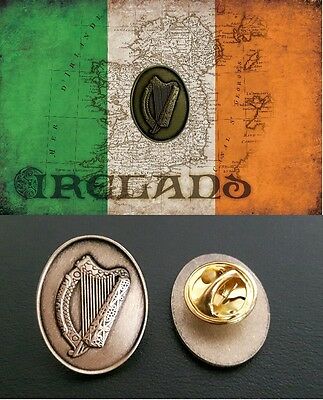Official Irish Harp Pin™ national emblem lapel pin, good luck charm, Ireland,
$3.69 (-40%)
The classic
official Irish Harp Pin™
22mmx17mm antique bronze oval pin with butterfly clutch on back, displaying the
classic Trinity College Brian Boru Harp adopted and officialised by the Irish
Free State in 1922.
Non-political, non-religious, the official Irish Harp Pin™ is a timeless
classic statement for Ireland and it’s heritage all over the world for everyone
with an Irish heart & spirit.
Get your own personal Irish Harp Pin™.
Short History of the Irish Harp as national symbol
The traditional symbol of Ireland, the harp is said to reflect the immortality
of the soul. For centuries, it has been the beloved emblem of Ireland.
It was adopted as the insignia of the Irish Free State when it separated from
the United Kingdom in 1922 and was registered as the arms of Ireland with
the Chief Herald of Ireland on 9 November 1945, appearing on official
government documents as well as the Presidential flag and being displayed on
Irish coins, not to mention the global trademark Guinness and Ryanair harp.
References to
the harp as being the arms of the King of Ireland can be found as early as
the 13th century. Recognized as a symbol of Ireland and Irish pride, the Gaelic
harp became an emblem of resistance to the Crown and England. As such, it was
banned at the end of the medieval period.
The depiction
of the harp has changed over time. In the 17th century, during the period of
the Kingdom of Ireland, the pillar of the harp began to be depicted as a
bare-breasted woman. The design of the harp used by the modern independent
Irish state in 1922 was based on the Brian Boru harp, a late-medieval Gaelic harp
kept in Trinity College, Dublin. No heraldic motto has ever been granted to
Ireland and none ever accompanies the coat of arms.
Ireland has
long been associated with a flag also bearing the harp. The
earliest-known record of the green flag is attributed to Eoghan Ruadh
O’Neill, a 17th-century exile and soldier in the Irish brigade
of the Spanish army. His ship, the St. Francis, is recorded as flying from her
mast top “the Irish harp in a green field, in a flag” as she lay at
anchor at Dunkirk en route to Ireland. O’Neill was returning to Ireland in
order to participate in the Irish Confederate Wars (1641—1653), during the
Wars of the Three Kingdoms (a series of civil wars engulfing England,
Ireland and Scotland), where he would contribute as a leading general. Variants
of the green flag were flown by Untied Irishmen during the 1798
Rebellion and by the Irish emigre in foreign armies, such as the
Irish Brigade of the Union Army during the American Civil War (1861–1865)
and Saint Patrick’s Battalion in the Mexican Army during the
Mexican-American War (1846–1848).
Although the
Kingdom of Ireland never had an official flag, this flag is recorded as the
flag of Ireland by 18th and 19th century sources. It was used as a naval
jack and as the basis for the unofficial green ensign of Ireland,
particularly during the 18th and 19th centuries.
Folklore says
that the first harp was owned by Dagda, a chief among the Tuatha De Danaan. The
De Danaan were at war with the Fomorians and the harp was taken from Dagda by
the gods of cold and darkness. Two other gods, Lugh representing light, and
Ogma representing art, penetrated the Fomorian fortress, recovered the harp and
restored it to Dagda. The gods in returning the harp to him, pronounced two
secret names for the instrument and, at the same time, called forth summer and
winter. From that point on, when Dagda played, he could produce a melody so
poignant, it would make his audience weep, an air so jubilant it would make
everyone smile, or a sound so tranquil, it would lull all who listened to
sleep. Thus, with its secret or magical names, the instrument became the
dispenser of Sorrow, Gladness and Rest.
Wear your
official Irish Harp Pin with pride.
GPO, Easter Rising, Irish War of Independence, the Civil war, deVallera, Free State, Home Rule, Ulster Connacht, Munster, Leinster, Dublin, Mayo, Galway, Cork, Belfast, Derry, Donegal, Kilkenny, Wild Geese, Emigration, Diaspora, Ireland, Irish, Erin, Fianna, Erin go Bragh, Poblacht na h-Eireann, Pádraig Pearse, 1916 Irish Rebellion, 1798, Fenian, Brotherhood, Hibernia, Northern Ireland, Irish Republic, Army, Navy, Air Force, General Post Office, O’Connell Street, Irish Defence Forces, Battle of the Somme, Irish Regiment, 1916 Rising, Louth, Wexford, Meath, Boland’s Bakery, Jacob’s Factory, the Royal College of Surgeons, South Dublin Union, Four Courts Provisional Government, Volunteers, Thoms MacDonagh, Thomas James Clarke, Sean MacDiarmada, Jospeh Mary Plunkett, James Connolly, Eamon Ceannt, Erskine Childers, Molly Childers, Sir Roger Casement, Alice Green, Mary Spring Rice, Howth gun running, Asgard, Yacht, Mauser Rifle, Enfield Rifle, Lewis gun, Machine gun, Webley, Revolver, .303, Chotah Kilcoole, County Wicklow, Sir Thomas Myles, Tom Kettle, James Meredith, Kelpie, Ruytingen buoy, Hamburg, Curragh incident, Curragh Mutiniy, Connaught Rangers, Munster Fusiliers, Leinster Fusilier, Dublin Fusiliers, Irish Fusiliers, Éamon de Valera, Cogadh na Saoirse, Anglo-Irish War, Sinn Féin, Dáil Éireann, Black and Tan War, Tan War, Royal Irish Constabulary, Defence of the Realm, Ambush, Flying Column, Partition, Anglo-Irish Treaty, Catholic, Irish Republican Brotherhood, First World War, Dublin Castle, 16th (Irish) Division, Emmet Dalton, Tom Barry, Martin Doyle, Michael Collins, Squad, Soloheadbeg Ambush, County Tipperary, Seán Treacy, Séamus Robinson, Seán Hogan, Dan Breen, Arthur Griffith, civil disobedience, Cathal Brugha, Irish Republican Police, Richard Mulcahy,Liam Lynch, Tom Barry, Seán Moylan, Seán Mac Eoin and Ernie O’Malley Cumann na mBan, Croke Park, Bloody Sunday, Young Ireland, 1848, W. B. Yeats, Gaelic Athletic Association, Gaelic League, Banna Strand, St. Stephen’s Green, Thomas Ashe, Richard Mulcahy, Liam Mellows, Edward Daly, Michael O’Hanrahan, John MacBride, Michael Mallin, Sean Heuston, Conn Colbert, Sir Roger Casement, Fine Gael, Easter Monday 24 April 1916, Easter Saturday 29 April 1916, Constance Markievicz, Countess Markievicz,Prehistoric Ireland, Celtic Christianity, “protohistoric”, Gaelic Ireland, Norman invasion, United Irishmen, Troubles, Passage Tombs, Newgrange, Irish Megalithic Tombs,Kingdoms of ancient Ireland, Dál Riata, Hibernia, St. Patrick, illuminated manuscripts, Dublin Bay, Battle of the Boyne, Catholic Church, High Kings, Tara, Druids, Celts, Uí Neíll, Clontarf, Aengus, Lir, Balor, Lug, Manannan, Dagda, Cú Chulainn, William Butler Yeats, Goll mac Morna, Finn Mac Cool, Other World, Little People, Voyage of St. Brendan, St. Columba,
Atlas of the Irish Revolution,

